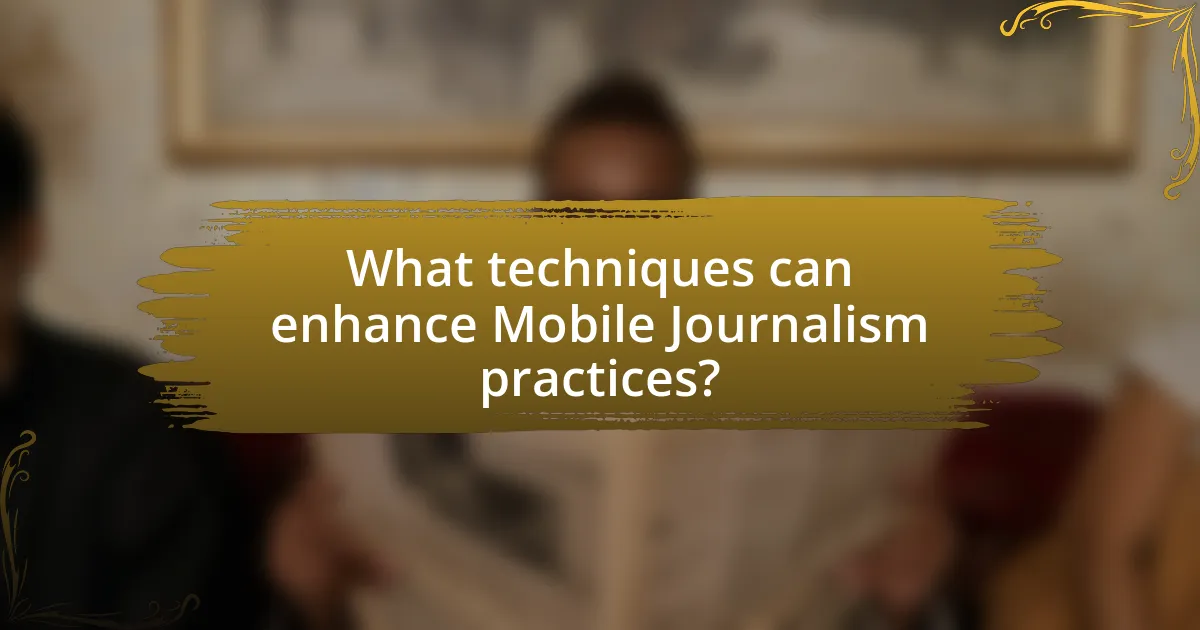Mobile journalism is the practice of reporting news using mobile devices, enabling journalists to capture, edit, and distribute content efficiently. The article explores the evolution of mobile journalism, highlighting advancements in technology, the impact of social media, and the importance of mobile reporting in today’s media landscape. It discusses essential tools and applications for mobile journalists, effective storytelling techniques, and ethical considerations, emphasizing how mobile journalism democratizes news reporting and enhances audience engagement. Additionally, it provides practical tips for successful mobile journalism, including coverage planning and troubleshooting common issues.

What is Mobile Journalism?
Mobile journalism is the practice of reporting news using mobile devices, such as smartphones and tablets, to capture, edit, and distribute content. This approach allows journalists to produce high-quality multimedia stories on-the-go, leveraging the capabilities of mobile technology, including video recording, photography, and social media integration. The rise of mobile journalism has been facilitated by advancements in mobile technology, with studies indicating that over 80% of news consumers access information via mobile devices, highlighting the importance of this medium in contemporary reporting.
How has Mobile Journalism evolved over the years?
Mobile journalism has evolved significantly over the years, transitioning from basic mobile reporting to sophisticated multimedia storytelling. Initially, mobile journalism relied on simple text updates and low-quality images, primarily using early smartphones. As technology advanced, the introduction of high-resolution cameras, editing apps, and social media platforms transformed mobile journalism into a dynamic form of reporting.
By 2010, the rise of apps like Instagram and Twitter enabled journalists to share real-time updates and engage with audiences directly. The proliferation of 4G and later 5G networks further enhanced this evolution, allowing for live streaming and high-quality video content. According to a 2021 report by the Reuters Institute for the Study of Journalism, 60% of journalists now use mobile devices as their primary reporting tool, highlighting the shift towards mobile-centric news production.
This evolution reflects a broader trend in the media landscape, where immediacy and accessibility have become paramount, enabling journalists to cover stories from anywhere in the world with unprecedented speed and efficiency.
What technological advancements have influenced Mobile Journalism?
Technological advancements that have influenced Mobile Journalism include the proliferation of smartphones, advancements in mobile editing software, and the availability of high-speed internet. Smartphones, equipped with high-resolution cameras and powerful processors, enable journalists to capture and edit video and audio content on the go. Mobile editing software, such as Adobe Premiere Rush and iMovie, allows for quick editing and publishing directly from mobile devices, streamlining the news production process. Additionally, high-speed internet connectivity, including 4G and 5G networks, facilitates real-time reporting and live streaming, enhancing the immediacy and reach of mobile journalism. These advancements collectively empower journalists to produce and disseminate news content more efficiently and effectively.
How has the rise of social media impacted Mobile Journalism?
The rise of social media has significantly transformed mobile journalism by enhancing the speed and accessibility of news dissemination. Journalists can now report and share news in real-time through platforms like Twitter and Facebook, allowing for immediate audience engagement and feedback. According to a 2021 Pew Research Center study, 53% of U.S. adults reported getting news from social media, highlighting its role as a primary news source. This shift has led to a more interactive and participatory form of journalism, where audiences can contribute content and share their perspectives, further democratizing the news landscape.
Why is Mobile Journalism important in today’s media landscape?
Mobile journalism is important in today’s media landscape because it enables reporters to produce and disseminate news quickly and efficiently using smartphones and portable technology. This immediacy is crucial in an era where audiences demand real-time updates, especially during breaking news events. According to a 2021 report by the Reuters Institute for the Study of Journalism, 70% of people access news via mobile devices, highlighting the necessity for journalists to adapt to this trend. Furthermore, mobile journalism democratizes content creation, allowing anyone with a smartphone to report news, thereby increasing diverse voices in media.
What role does Mobile Journalism play in democratizing news reporting?
Mobile Journalism plays a crucial role in democratizing news reporting by enabling individuals to create and share news content using mobile devices, thus reducing barriers to entry in the media landscape. This accessibility allows a diverse range of voices, including those from marginalized communities, to participate in news creation and dissemination. According to a 2020 report by the Reuters Institute for the Study of Journalism, 62% of people globally access news via mobile devices, highlighting the shift towards mobile platforms as primary sources of information. This trend empowers citizen journalists and enhances public engagement, fostering a more inclusive media environment.
How does Mobile Journalism enhance audience engagement?
Mobile Journalism enhances audience engagement by enabling real-time content creation and distribution through mobile devices. This immediacy allows journalists to share breaking news and updates directly with their audience, fostering a sense of connection and involvement. According to a study by the Pew Research Center, 72% of adults in the U.S. get news on social media, highlighting the effectiveness of mobile platforms in reaching audiences where they are most active. Additionally, mobile journalism often incorporates interactive elements such as polls, live Q&A sessions, and multimedia content, which further engage viewers and encourage participation.

What tools are essential for Mobile Journalists?
Essential tools for mobile journalists include a smartphone with a high-quality camera, audio recording equipment, video editing software, and social media platforms for distribution. Smartphones like the latest iPhone or Samsung Galaxy models provide advanced camera capabilities and apps for editing and publishing content. Audio recording equipment, such as external microphones, enhances sound quality for interviews and reports. Video editing software, like Adobe Premiere Rush or iMovie, allows for quick editing on the go. Social media platforms, including Twitter, Facebook, and Instagram, serve as vital channels for sharing news and engaging with audiences. These tools collectively enable mobile journalists to produce and disseminate high-quality content efficiently.
Which mobile devices are best suited for journalism?
Smartphones, particularly models like the Apple iPhone 14 Pro and Samsung Galaxy S23 Ultra, are best suited for journalism due to their advanced camera systems, high processing power, and robust app ecosystems. These devices enable journalists to capture high-quality images and videos, edit content on-the-go, and access various reporting tools and social media platforms seamlessly. For instance, the iPhone 14 Pro features a triple-camera system with ProRAW capabilities, allowing for professional-grade photography, while the Galaxy S23 Ultra offers a 200 MP camera that excels in low-light conditions. Both devices support essential journalism apps such as Adobe Premiere Rush for video editing and Evernote for note-taking, enhancing productivity and efficiency in the field.
What features should journalists look for in a mobile device?
Journalists should look for a mobile device with a high-quality camera, robust battery life, and reliable connectivity options. A high-quality camera is essential for capturing clear images and videos, which are crucial for reporting. Robust battery life ensures that the device can last through long reporting days without needing frequent recharges. Reliable connectivity options, including 4G or 5G capabilities, allow journalists to upload content quickly and stay connected in various environments. These features are supported by the increasing demand for real-time reporting and multimedia content in journalism today.
How do different operating systems affect Mobile Journalism tools?
Different operating systems significantly affect mobile journalism tools by influencing app availability, performance, and user experience. For instance, iOS typically offers a more curated selection of high-quality journalism apps, such as Adobe Premiere Rush and LumaFusion, which are optimized for performance and user interface. In contrast, Android provides a wider variety of apps but may face fragmentation issues, leading to inconsistent performance across devices. Additionally, iOS devices often receive updates and new features faster, enhancing the functionality of journalism tools, while Android’s diverse hardware can result in delayed updates and varying app compatibility. This disparity impacts journalists’ ability to access and utilize the best tools for reporting effectively.
What applications are crucial for Mobile Journalists?
Crucial applications for Mobile Journalists include Adobe Premiere Rush for video editing, Anchor for podcasting, and Canva for graphic design. Adobe Premiere Rush allows journalists to edit videos on-the-go with user-friendly features, making it ideal for quick turnaround times. Anchor provides a platform for creating and distributing podcasts easily, which is essential for audio storytelling. Canva enables the creation of visually appealing graphics and social media posts, enhancing the visual aspect of reporting. These applications collectively support the diverse needs of mobile journalists in producing high-quality content efficiently.
Which apps are best for video editing on mobile devices?
The best apps for video editing on mobile devices include Adobe Premiere Rush, Kinemaster, and InShot. Adobe Premiere Rush offers a user-friendly interface and integrates well with Adobe Creative Cloud, making it suitable for both beginners and professionals. Kinemaster provides advanced features like multi-layer editing and chroma key, appealing to users who require more control over their projects. InShot is popular for its simplicity and social media optimization tools, allowing users to create videos quickly for platforms like Instagram and TikTok. These apps are widely recognized for their functionality and ease of use, making them top choices for mobile video editing.
How can journalists use social media apps effectively for reporting?
Journalists can use social media apps effectively for reporting by leveraging real-time information sharing, audience engagement, and multimedia content creation. These platforms allow journalists to disseminate news quickly, gather immediate feedback, and interact with their audience, enhancing the overall reporting process. For instance, Twitter’s character limit encourages concise updates, while Instagram and TikTok enable visual storytelling, which can capture audience attention more effectively. According to a Pew Research Center study, 53% of U.S. adults say they often get news from social media, highlighting its significance in modern journalism.

What techniques can enhance Mobile Journalism practices?
Techniques that can enhance Mobile Journalism practices include utilizing high-quality mobile editing apps, leveraging social media for real-time reporting, and employing effective storytelling techniques. High-quality mobile editing apps, such as Adobe Premiere Rush and Kinemaster, allow journalists to edit video and audio content directly on their devices, streamlining the production process. Leveraging social media platforms like Twitter and Instagram enables journalists to share updates and engage with audiences instantly, fostering a more interactive reporting experience. Effective storytelling techniques, including the use of visuals and concise narratives, help capture audience attention and convey information clearly. These techniques collectively improve the quality and impact of mobile journalism.
How can Mobile Journalists improve their storytelling skills?
Mobile journalists can improve their storytelling skills by mastering the use of mobile technology and narrative techniques. By utilizing high-quality mobile devices equipped with advanced cameras and editing software, journalists can capture compelling visuals and audio that enhance their stories. Additionally, understanding the principles of storytelling, such as structure, character development, and emotional engagement, allows mobile journalists to create narratives that resonate with their audience. Research indicates that effective storytelling can increase audience retention and engagement, as seen in studies by the Pew Research Center, which highlight the importance of narrative in digital media.
What narrative techniques work best in mobile formats?
Visual storytelling techniques, such as short videos and infographics, work best in mobile formats. These techniques leverage the small screen size and quick consumption habits of mobile users, allowing for engaging and easily digestible content. Research indicates that mobile users prefer content that is visually appealing and concise, with studies showing that videos can increase engagement by up to 1200% compared to text alone. Additionally, interactive elements like polls and quizzes enhance user participation, making the narrative more immersive.
How can visuals be effectively integrated into mobile stories?
Visuals can be effectively integrated into mobile stories by using high-quality images, videos, and graphics that enhance the narrative and engage the audience. Research indicates that stories with visuals are 94% more likely to be viewed than those without, highlighting the importance of visual content in capturing attention. Additionally, incorporating visuals that are contextually relevant and strategically placed throughout the story can improve comprehension and retention, as studies show that people remember 80% of what they see compared to only 20% of what they read. Therefore, utilizing compelling visuals not only enriches the storytelling experience but also significantly boosts audience engagement and information retention.
What ethical considerations should Mobile Journalists keep in mind?
Mobile journalists should prioritize accuracy, transparency, and respect for privacy in their reporting. Accuracy ensures that the information presented is factual and reliable, which is crucial in maintaining credibility. Transparency involves disclosing sources and methods used in gathering information, fostering trust with the audience. Respect for privacy is essential, particularly when reporting on sensitive subjects or individuals, as it protects the rights and dignity of those involved. These ethical considerations are supported by the Society of Professional Journalists’ Code of Ethics, which emphasizes the importance of ethical standards in journalism.
How can Mobile Journalists ensure accuracy and credibility?
Mobile journalists can ensure accuracy and credibility by verifying information through multiple reliable sources before publication. This practice is essential as it helps to confirm the authenticity of facts and reduces the risk of disseminating misinformation. For instance, a study by the Pew Research Center found that 64% of journalists prioritize fact-checking to maintain credibility in their reporting. Additionally, mobile journalists should utilize established journalistic standards, such as the Society of Professional Journalists’ Code of Ethics, which emphasizes the importance of accuracy and accountability in reporting. By adhering to these guidelines and employing rigorous verification methods, mobile journalists can enhance the trustworthiness of their work.
What are the privacy concerns associated with Mobile Journalism?
Mobile journalism raises significant privacy concerns primarily due to the ease of capturing and disseminating personal information without consent. Journalists using mobile devices can inadvertently record private moments or sensitive data in public spaces, leading to potential violations of individuals’ privacy rights. For instance, the use of smartphones equipped with high-resolution cameras and recording capabilities allows for the documentation of events in real-time, which can include private individuals who may not wish to be featured in news coverage. Additionally, the storage and transmission of this data can be vulnerable to breaches, exposing personal information to unauthorized access. According to a 2021 study by the Pew Research Center, 81% of Americans feel they have little to no control over the data collected about them, highlighting the widespread concern regarding privacy in the digital age, particularly in the context of mobile journalism.
What are the best practices for successful Mobile Journalism?
The best practices for successful Mobile Journalism include using high-quality equipment, mastering storytelling techniques, and ensuring effective audience engagement. High-quality equipment, such as smartphones with advanced cameras and audio recording capabilities, enhances the production value of mobile reports. Mastering storytelling techniques involves structuring narratives that are compelling and concise, which is essential in capturing audience attention in a fast-paced digital environment. Effective audience engagement can be achieved through interactive content, social media integration, and real-time updates, which foster a connection with viewers and encourage sharing. These practices are supported by the growing trend of mobile consumption, with reports indicating that over 50% of global web traffic comes from mobile devices, highlighting the importance of optimizing content for mobile platforms.
How can Mobile Journalists effectively plan their coverage?
Mobile journalists can effectively plan their coverage by conducting thorough research on the story, identifying key sources, and creating a detailed outline of the coverage plan. This approach ensures that journalists understand the context and significance of the story, which is crucial for delivering accurate and engaging content. For instance, a study by the Pew Research Center highlights that 62% of mobile journalists prioritize understanding their audience’s interests, which directly influences their planning process. By utilizing tools such as editorial calendars and mobile apps for real-time updates, journalists can streamline their workflow and adapt to changing circumstances during coverage.
What tips can help Mobile Journalists troubleshoot common issues?
Mobile journalists can troubleshoot common issues by following these tips: first, ensure that all software and apps are updated to the latest versions, as updates often fix bugs and improve performance. Second, check the device’s storage space; insufficient storage can lead to app crashes or slow performance. Third, restart the device regularly to clear temporary files and refresh system resources. Fourth, use external microphones for better audio quality, as built-in microphones may not capture sound effectively in noisy environments. Lastly, familiarize yourself with the settings of your camera and editing apps to optimize their use for specific reporting needs. These practices are supported by user experiences and technical guidelines from mobile journalism resources.

Leave a Reply